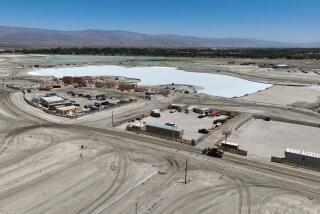The Sweet Smell of Cerritos : The master-planned city, established in 1956 by dairymen, is a paradigm of the successful community, from its wide range of ethnic groups to its robust financial base.
- Share via
The towering Cerritos Center for the Performing Arts, host of world-class performers such as Frank Sinatra and the Royal Shakespeare Company, rises from land once roamed by dairy cows.
A short distance away, senior citizens pass the day in a $4.5-million complex that features an exercise room with motorized treadmills, an audio-visual room with computers, a billiards room and a courtyard with a meticulous koi pond.
The city opens its library seven days a week, and had enough money left over to help the local school district upgrade its gymnasiums.
From the pungent cow odors that once permeated town, Cerritos has emerged with a sweet smell of success.
While many Southland cities waddle each year through a puddle of bad economic news, Cerritos is a municipal swan sitting on a huge nest egg of reserve, one that could maintain city services for more than three years. And the city is moving aggressively toward more wealth, with construction under way on a $7.6-million addition to the Towne Center, the city’s office and commercial hub.
“One thing we’re really proud of is we don’t have any budget problems,” said Mayor Grace Hu. “This city is well planned.”
It was master-planned from the start, although initially dairy cows and their owners were the main beneficiaries.
Founded in 1956 by dairymen who feared their farms would be swallowed by the growing urban sprawl, Cerritos--then called Dairy Valley--was populated in the mid-1960s by 3,500 people and about 100,000 head of cattle.
But as land values skyrocketed, all that changed faster than you could milk a cow. Dairymen with dollar signs in their eyes relinquished their hold on the city to reap a windfall by moving their operations to Chino and other outlying areas, where land was a bargain.
People became the new growth industry. Tract after tract of middle-class houses sprouted from dairy land. Young families seeking refuge from crime and other ills moved into the new community, renamed Cerritos.
Their steady middle-class demographics transformed Cerritos into an affluent bedroom community with a median household income of about $59,000 a year--and one of the most ethnically diverse cities in the nation.
By all accounts, the various ethnic groups live in relative harmony, residents say.
The city’s crime rate is stable and comparable to those of the cities around it. Big events don’t happen all that often in Cerritos.
Yet a national tragedy cast a spotlight on the city nine years ago. An Aeromexico jetliner and a small plane collided above Cerritos and plummeted to the ground on Aug. 31, 1986. The crash killed 67 people aboard the planes and 14 on the ground. Ten homes were destroyed.
Next year, the city probably will hold a memorial service to mark the 10th anniversary of the crash, officials said.
Gail Grossman, who lives with her family several doors away from the crash site, remembers seeing the shadow of the jetliner just before impact. Grossman took in a family that lost its home to the crash.
“It could have easily been in our front yard,” Grossman said. “It was hard for anybody to go into the house at night. . . . I had a real difficult time going into malls or inside a store, any place I couldn’t see what was going on around me.”
But as the years pass, talk of the crash among longtime residents surfaces less and less; some new arrivals don’t even know about it. Redevelopment started the city’s economic engine revving in 1969 and it has been firing on all cylinders ever since. City officials aggressively pursued redevelopment after one of the nation’s largest shopping center developers, the Ernest Hahn Co., issued an ultimatum: Hahn would abandon a pending mall project in the city if Cerritos did not widen streets and make other improvements, the cost of which could be recouped through a redevelopment program.
Several months later, the City Council agreed to create its first redevelopment zone from 820 acres of undeveloped property, including Hahn’s. In all, $1.2 million in property taxes were spent on streets, sidewalks, lights and other improvements for the sprawling, successful, Los Cerritos Center mall, which opened in 1971.
Then came the Cerritos Auto Square, which opened in 1980 and has become one of the highest-grossing car malls in the nation. Cerritos lured dealerships away from nearby cities with a promise of cheap land in an attractive setting--sidewalks, benches and landscaping--courtesy of the Cerritos Redevelopment Agency.
The first tenants moved into the Towne Center in 1987. And the development’s crowning jewel, the $60-million Cerritos Center for the Performing Arts, opened in 1993.
The developments--all of them in redevelopment zones--generate more and more property tax dollars that by law must be used for additional, subsidized growth.
At the same time, the completed projects generate millions of dollars in sales taxes that pay for city services, including law enforcement and fire protection. Sales taxes are expected to account for about $17.4 million of the $53 million the city will spend on general operations this fiscal year, officials say.
Not only has the revenue generated by virtue of redevelopment enabled the city to provide a wealth of services to its residents, but the redevelopment projects have also created thousands of new jobs in Cerritos, they add. In all, the city has 31,000 jobs, a spokeswoman said, more than the total number of workers who live in the city.
“Would this have happened without [redevelopment]?” said City Manager Art Gallucci, who started working for the city more than 20 years ago and worked his way up to become city manager in 1991. “I don’t think so.”
But at least some Cerritos residents question whether city officials might be in over their heads, whether the city will always be able to afford the services it now provides. The Center for the Performing Arts, for example, runs about $3 million in the red annually, a shortfall subsidized by the city.
The city always seems to have some new project in the works. This year, construction will start on a $9-million sheriff’s substation the city is building so its deputies will be based in Cerritos instead of in neighboring Lakewood.
Those concerns aside, several residents praised the city as a fine home. “It offers a lot. There are parks everywhere,” said Jon Barton, 17, sitting outside his school, Cerritos High, which was recently refurbished compliments of the city. “We have a lot of services they don’t have in other cities.”
More to Read
Sign up for Essential California
The most important California stories and recommendations in your inbox every morning.
You may occasionally receive promotional content from the Los Angeles Times.









